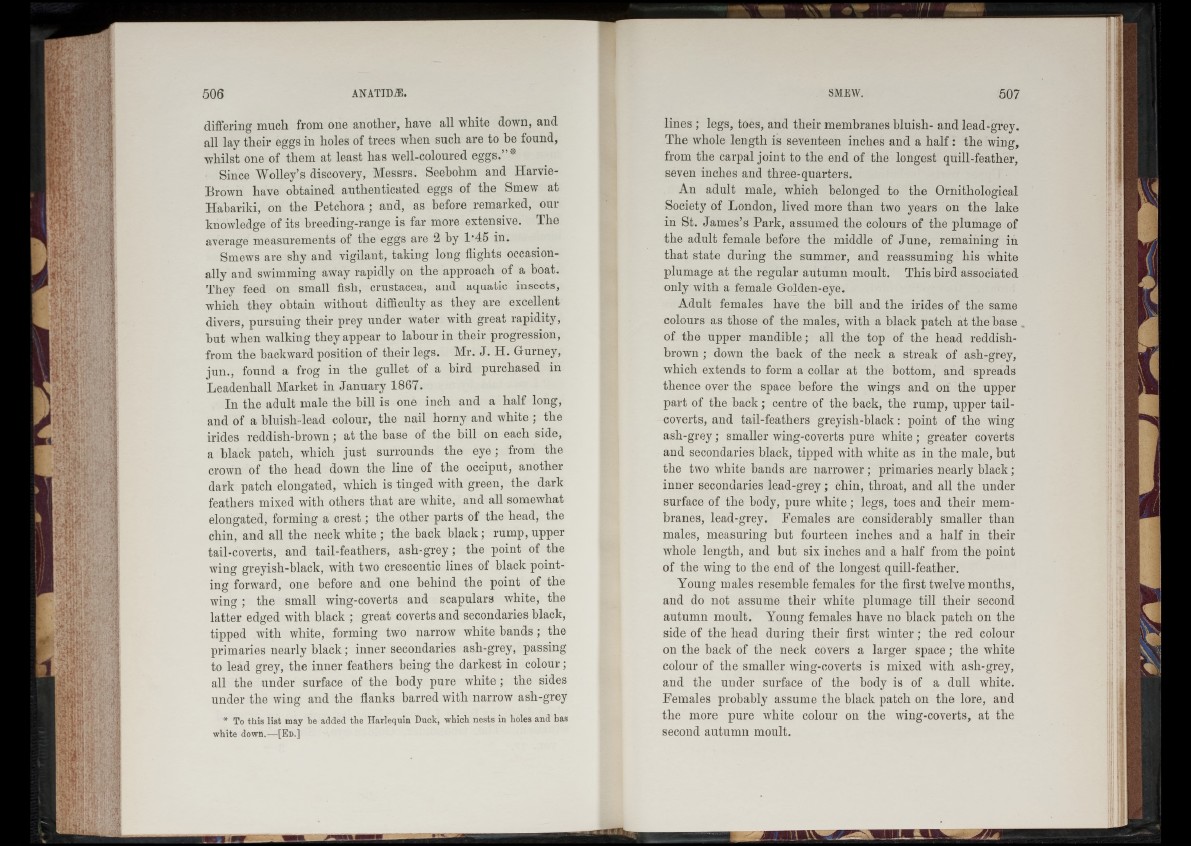
differing much from one another, have all white down, and
all lay their eggs in holes of trees when such are to be found,
whilst one of them at least has well-coloured eggs.” *
Since Wolley’s discovery, Messrs. Seebohm and Harvie-
Brown have obtained authenticated eggs of the Smew at
Habariki, on the Petchora ; and, as before remarked, our
knowledge of its breeding-range is far more extensive. The
average measurements of the eggs are 2 by 1'45 in.
Smews are shy and vigilant, taking long flights occasionally
and swimming away rapidly on the approach of a boat.
They feed on small fish, Crustacea, and aquatic insects,
which they obtain without difficulty as they are excellent
divers, pursuing their prey under water with great rapidity,
but when walking they appear to labour in their progression,
from the backward position of their legs. Mr. J . H. Gurney,
jun., found a frog in the gullet of a bird purchased in
Leadenliall Market in January 1867.
In the adult male the bill is one inch and a half long,
and of a bluish-lead colour, the nail horny and white ; the
irides reddish-brown ; at the base of the bill on each side,
a black patch, which just surrounds the eye; from the
crown of the head down the line of the occiput, another
dark patch elongated, which is tinged with green, the dark
feathers mixed with others that are white, and all somewhat
elongated, forming a crest; the other parts of the head, the
chin, and all the neck white ; the back black; rump, upper
tail-coverts, and tail-feathers, ash-grey ; the point of the
wing greyish-black, with two crescentic lines of black pointing
forward, one before and one behind the point of the
wing ; the small wing-covert3 and scapulars white, the
latter edged with black ; great coverts and secondaries black,
tipped with white, forming two narrow white bands ; the
primaries nearly black; inner secondaries ash-grey, passing
to lead grey, the inner feathers being the darkest in colour;
all the under surface of the body pure white ; the sides
under the wing and the flanks barred with narrow ash-grey
* To this list may be added the Harlequin Duck, which nests in holes and has
white down.—[Ed.]
lines ; legs, toes, and their membranes bluish- and lead-grey.
The whole length is seventeen inches and a half: the wing,
from the carpal joint to the end of the longest quill-feather,
seven inches and three-quarters.
An adult male, which belonged to the Ornithological
Society of London, lived more than two years on the lake
in St. James’s Park, assumed the colours of the plumage of
the adult female before the middle of June, remaining in
that state during the summer, and reassuming his white
plumage at the regular autumn moult. This bird associated
only with a female Golden-eye.
Adult females have the bill and the irides of the same
colours as those of the males, with a black patch at the base
of the upper mandible; all the top of the head reddish-
brown ; down the back of the neck a streak of ash-grey,
which extends to form a collar at the bottom, and spreads
thence over the space before the wings and on the upper
part of the back; centre of the back, the rump, upper tail-
coverts, and tail-feathers greyish-black: point of the wing
ash-grey; smaller wing-coverts pure white ; greater coverts
and secondaries black, tipped with white as in the male, but
the two white bands are narrower ; primaries nearly black ;
inner secondaries lead-grey ; chin, throat, and all the under
surface of the body, pure white ; legs, toes and their membranes,
lead-grey. Females are considerably smaller than
males, measuring but fourteen inches and a half in their
whole length, and but six inches and a half from the point
of the wing to the end of the longest quill-feather.
Young males resemble females for the first twelvemonths,
and do not assume their white plumage till their second
autumn moult. Young females have no black patch on the
side of the head during their first winter ; the red colour
on the back of the neck covers a larger space ; the white
colour of the smaller wing-coverts is mixed with ash-grey,
and the under surface of the body is of a dull white.
Females probably assume the black patch on the lore, and
the more pure white colour on the wing-coverts, at the
second autumn moult.